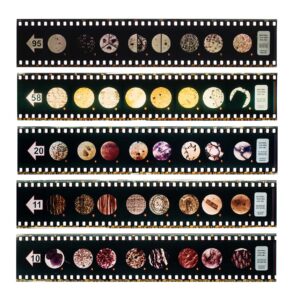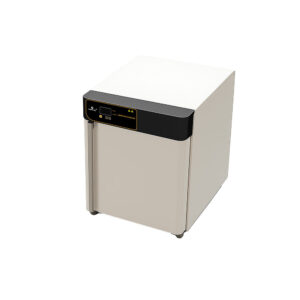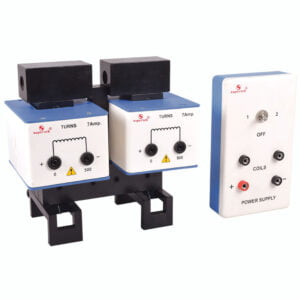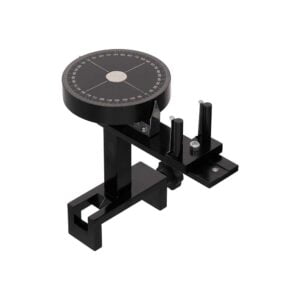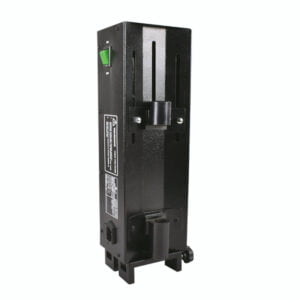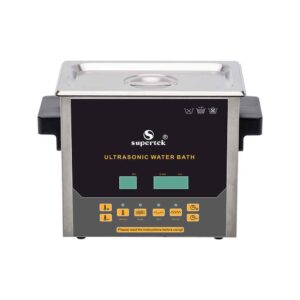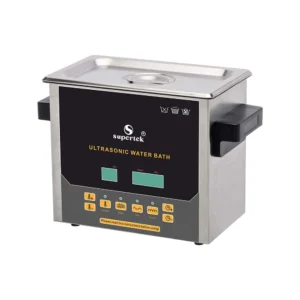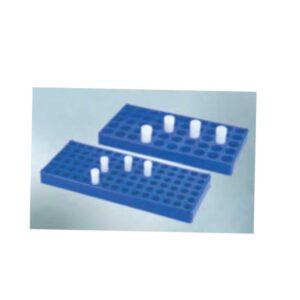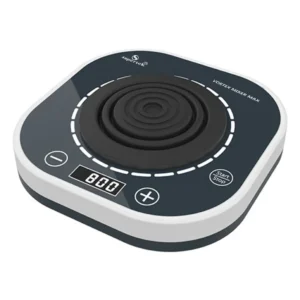-
Accessories
Electromagnet Set Assembly
The Electromagnet set includes U core, pole pieces coils (x 2), and coils (x 2) mounted on two uprights.
Specifications:
- Coils
• 500 turns
• Current: 7A(Max.)
• Wire: 17 SWG, Copper
• Connections: 4mm safety socket - U Core
• 150 x 130mm (Lx H), 40 x 40mm cross-section - Pole Pieces
• Length = 75mm
• Material: Ferromagnetic
UP025 - Coils
-
Accessories
Rotating Table Assembly
A simple, smooth, and compact rotating table. The rotating table used is extremely smooth to operate. It is a single assembly that holds a glass sample, analyzer, and light sensor, thus minimizing the size of the whole equipment. Smooth rotation makes measurement continuous and accurate.
UP030 -
Accessories
Telescope Assembly
The telescope on the rotating table is mounted with bearings for smooth rotation. The diffraction grating mounted is mounted at the center of the rotating table. The telescope is easy to focus on and operate. The angle of the rotating arm has a least count of 0.1° for accurate measurement of the spectral lines.
UP035 -
Accessories
Spectrum Tube Power Supply Assembly
The built-in power supply makes a more compact system with easier changing of the discharge tubes. Easy power connection and no unnecessary wire intrusions.
Specifications:
- Input Voltage: 220V, 50 Hz AC.
- Output Voltage: 0-5000V (open circuit).
- Socket: Spring loaded.
UP040 -
Water Bath
Ultrasonic Water Bath, PRO
Ultrasonic baths are widely utilized in industries such as scientific research, laboratories, medicine, electronics, jewelry, and dentistry, where precise cleaning is essential.
Features
- Normal and gentle power modes to effectively clean even the hard-to-reach areas.
- Degassing feature to boost cleaning performance.
- Customizable timer settings ranging from 1 to 99 minutes.
- Adjustable heating function with temperatures ranging from Ambient +5°C to 80°C.
- Intuitive interface with an easy-to-navigate control panel.
- Convenient memory function to save your settings.
- LED display for real-time monitoring of temperature and timer.
- High-efficiency transducer for exceptional cleaning results.
Technical Specifications
- Operating frequency: 40 ± 3 kHz
- Temperature range: Ambient + 5°C to 80° C
- Timer Range: 1 to 99 mins
- Input voltage: 220 V AC ± 10%, 50-60 Hz
- CE certified
USB-P -
Heating & Tempering
Ultrasonic Water Baths, PRO
Ultrasonic baths are widely utilized in industries such as scientific research, laboratories, medicine, electronics, jewelry, and dentistry, where precise cleaning is essential.
Features:
- Degassing feature to boost cleaning performance.
- Convenient memory function to save your settings.
- Intuitive interface with an easy-to-navigate control panel.
- Customizable timer settings ranging from 1 to 99 minutes.
- High-efficiency transducer for exceptional cleaning results.
- LED display for real-time monitoring of temperature and timer.
- Normal and gentle power modes to effectively clean even the hard-to-reach areas.
- Adjustable heating function with temperatures ranging from Ambient +5°C to 80°C.
Technical Specifications:
- CE certified
- Timer Range: 1 to 99 mins
- Operating frequency: 40 ± 3 kHz
- Input voltage: 220 V AC ± 10%, 50/60 Hz
- Temperature range: Ambient + 5°C to 80° C
USB-P -
Racks
Rack for Scintillation Vials
These Racks for Scintillation Vials, moulded in Polypropylene, are autoclavable & corrosion-resistant. There is an individual rack for both 8 ml & 20 ml vials. These rugged & stable racks can hold scintillation vials for convenient storage, handling & sample preparations.
VIA10012 -
Miscellaneous
Cryo Rack
Cryo Rack is moulded in Polycarbonate making it tough, durable & autoclavable. This handy rack can hold 50 vials at a time. The unique feature of this rack is that vials can be unscrewed without actually picking them up as the vials will lock in every well and hence will not twist. This rack is provided with four anti-skid rubbers & each well is identified with an alpha-numeric index.
VIA10020 -
Boxes
Cryo Box PC
Cryo Boxes are moulded in Polycarbonate making it extra strong and autoclavable. These can accommodate Cryo Vials of up to 4.5 ml. Capacity and are designed to be used at temperatures ranging from -190°C to +121°C. The transparent cover of the box gives a good view of the contents inside and is numbered for better inventory control.
VIA10022 -
Boxes
Cryo Box
Moulded in Polylpropylene, the top of the box is attached to the bottom through well-designed built-in hinges. The bottom has built-in spaces to hold vials up to 2 ml. capacity. Available in two different sizes, these autoclavable boxes bear alpha numeric index for easy identification of different vials place inside.
VIA10024 -
Mixing
Vortex Mixer, Max
The vortex mixer, max is an advanced lab device for fast, efficient sample mixing. It has an enlarged mixing area, a brushless motor, and a laser sensor, making it ideal for precision tasks that need speed control.
Product Features:
- Enlarged mixing surface: Suitable for a wide range of applications.
- High-Capacity Mixing: Capable of handling large sample volumes efficiently.
- Laser Sensor Activation: Turns on when a hand is detected and stops when removed.
- Ergonomic design enables fast mixing.
- Brushless motor for lasting performance with minimum maintenance.
Technical Specifications:
- Speed Range: 100 to 3000 RPM (Increment of 100 RPM)
- Shaking Stroke: 4mm (Circular)
- Operating Mode: Touch
- Digital Display
- Direction of Rotation: Clockwise
- Power Rating: 20W
- Input Voltage: Power Adapter 12V DC/2A (Included)
- Product Dimensions: 150 x 150 x 45mm
- IP Ratings: IP42
VM-MAX-01 -
Xperimentor
Optics Kit 1, Colours, Shadows, Opaque Object
IT’S ALL ABOUT OPTICS!
A series of three kits.
Kit 1 helps you explore the world of light and build your own camera.
What will you be learning?- Rectilinear propagation of light.
- Classification of Objects into transparent, translucent and Opaque
- Understanding formation of shadow.
- Understanding the different regions of a shadow.
- Understanding colour filters.
- Building a Pinhole Camera.
- Understanding dispersion of white light.
- Suitable for kids between Age of 7-15 Years.
- D.I.Y. Kits to provide Early Hands-on experience.
- An extensive Instruction Manual is provided with the kit.
XP-KIT-1 -
Xperimentor
Optics Kit 2, Lenses, Curved Mirrors, Magnification
IT’S ALL ABOUT OPTICS!
A series of three kits.
Kit 2 allows you to use your lens in different ways, like reflecting light and bending it.
What will you be learning?- Investigate the difference between regular and diffused reflection.
- Understanding the need of regular and spectacular reflection.
- Understanding the laws of reflection.
- Understanding Multiple Reflection.
- Building a kaleidoscope.
- Drawing Ray diagrams.
- Investigate the characteristics of an image formed in a plane mirror.
- Investigate the refraction when light travels through different mediums.
- Visualise the formation of total internal reflection.
- Explore the characteristics of a Prism.
- Suitable for kids between Age of 7-15 Years.
- D.I.Y. Kits to provide Early Hands-on experience.
- An extensive Instruction Manual is provided with the kit.
XP-KIT-2 -
Xperimentor
Optics Kit 3, Prisms, Ray Optics, Reflection
IT’S ALL ABOUT OPTICS!
A series of three kits.
Kit 3 helps you create colorful and special effects by taking. advantage of prisms.What will you be learning?
- Investigate the image formation of Spherical Mirrors & Lenses.
- Understand how curvature of mirror and lens affects image formation.
- Build your own lens.
- Build your own projector.
- Exploring Partial lens and its image formations.
- Understand human eye.
- Building your own optical Illusions.
- Suitable for kids between Age of 7-15 Years.
- D.I.Y. Kits to provide Early Hands-on experience.
- An extensive Instruction Manual is provided with the kit.
XP-KIT-3


